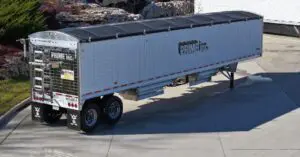A bright orange sign reads, “Reduce speed ahead.”
As you slow down, you see traffic cones in the distance and another sign that says, “Lane closed ahead.”
You’re traveling through a construction zone.
As a truck driver, you will encounter road construction, especially as the weather warms across the country and road projects kick back up. A work zone may include lane closures, shoulder closures, lane shifts, uneven surfaces, reduced speeds and detours for oncoming traffic.
When driving in work zones, you should follow the safety tips and techniques you practice daily as a truck driver. Keep reading for safe driving tips to consider in construction zones and beyond.
Safety Tips for Truck Drivers
1. Consider a Detour
Planning your trip can help you avoid major work zones. Research before you take off to find detours and bypass road work altogether.
Federal and state agencies share when large construction projects occur and often offer detours. You can use the National Traffic and Road Closure resource provided online by the Federal Highway Administration to find road closures in specific areas of the country.
2. Slow Down
When you enter a work zone, you should slow down, aiming to maintain the posted speed limit. Often, the posted speed limit is reduced within a construction zone, so watch for road signs that indicate a new temporary speed limit.
Large trucks take up to the length of two football fields to stop safely. Slowing down helps you keep your distance from other vehicles or come to a stop should you need to follow a flagger’s directions.
3. Maintain Your Distance
Driving too fast could have you following vehicles too closely, putting you at greater risk of causing an accident.
Rear-end collisions were about 15% higher in work zones than non-work zones from 2019 to 2021, according to the National Work Zone Safety Information Clearinghouse (a project of the American Road & Transportation Builders Association).
Use this tip from FMCSA to help maintain distance from the vehicle in front of you:
- For speeds below 40 mph, leave one second for every 10 feet of vehicle. While operating most trucks and trailers, drivers should keep about seven seconds of braking distance from other vehicles.
- For speeds above 40 mph, leave two seconds for every 10 feet of vehicle. Many highway work zones have reduced speeds between 45 and 55 mph. When entering work zones, double your braking distance.
Always look for reduced speed limit signage to ensure you slow to the posted speed.
4. Check Your Mirrors
No matter where you’re driving, checking your mirrors every 8 to 10 seconds helps you stay aware of the traffic around you.
Tractor-trailers have large blind spots on either side, as well as blind spots about 20 feet directly in the front of the truck and 30 feet directly behind the trailer. Maintaining awareness of vehicles around you helps you navigate changing traffic patterns.
5. Move to Open Lanes Quickly
Lane closures are common in road construction projects. If you spot an arrow or “lane closed ahead” sign, you want to move into the open lane as soon as you can. Since you’re operating large equipment, you should get over at the first opportunity.
You’ll still take your time completing your lane change—just don’t wait until you’re on top of traffic cones or barricades to begin trying to merge. Monitor the traffic around you and check your blind spots before changing lanes.
6. Follow Road Signs
The fluorescent orange signs in a work zone are there for a reason. Always follow the directions given by road signs.
Even if a construction zone seems inactive, you never know where workers could be ahead. Road maintenance and utility crews are often mobile, meaning they’re moving down the road as they work.
If you see signs indicating that workers or flaggers are ahead, it’s best to slow down and assume you’ll see them soon.
7. Stay Alert & Flexible
You keep track of many things when you’re driving. You continuously make decisions to operate safely. One of the most essential tips for safe driving is to stay alert and flexible, whether you’re going down the highway, a rural road or entering a work zone.
While driving in construction zones, you’ll see signs indicating what’s up ahead or warning you of changes in the traffic pattern. Read and interpret these signs as early as possible to start planning where to go. Beware of the traffic around you, workers and heavy machinery nearby, changes to road surfaces and debris.
8. Practice Patience
Sometimes, road work slows you down, putting a hitch in your day. Once you are in a construction zone, there isn’t anywhere else to go. Practice being patient instead of getting worked up. Follow directions from road signs or flaggers, and travel through the work zone safely.
9. Be Considerate to Other Drivers
Everyone is in the same boat when driving through a construction zone. Remember not to let frustration get the best of you. Stay calm and be considerate to other motorists. Being patient and considerate helps everyone exit the work zone safely.
10. Follow the Safety Practices You Know
While road construction can be frustrating, you’ll use the same best practices and tips for safe driving you apply to your driving every day. Stay vigilant, stay calm, and follow the construction zone’s signs to safely navigate changing traffic conditions and other work zone obstacles.
Start Your Career with CDL Safety Training
Get started today. New drivers will learn Class A CDL safety training in our Prime Training Program. Whether you’ve only dreamed of operating a semi or it’s your current profession, choose Prime Inc. to take your career to the next level—always with safety in mind.
Apply online and start your driving journey with Prime Inc. You can also call our Recruiting Department at 866-290-1568 to ask questions or apply by phone.


